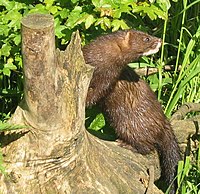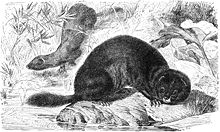European mink
| European Mink | |
|---|---|

| |
| Scientific classification | |
| Kingdom: | |
| Phylum: | |
| Class: | |
| Order: | |
| Family: | |
| Genus: | |
| Species: | M. lutreola
|
| Binomial name | |
| Mustela lutreola | |
The European Mink, Mustela lutreola, is a European member of the Mustelidae family found in some regions of Spain, France, Romania, Ukraine, Estonia and the greater part of Russia, though not found east of the Ural Mountains. Formerly it extended across all Europe, reaching Finland in the north, but it is now extinct in the major part of its ancient range. It is similar in appearance to the American Mink.
Description
Mink first entered Europe from America at the end of the Pleistocene Ice Age. The two species are believed to have diverged only in the last ten thousand years, and therefore remain remarkably similar in a number of ways. [1]

Physical appearance
European Mink have slender, flexible bodies, bushy tails, and webbed paws. They have a sleek summer coat, and a darker, denser, winter coat, better suited to low temperatures. Their eyesight is generally poor, so that they rely heavily on their superior sense of smell while hunting.[1]
It is sometimes possible to distinguish the European and American species based on the fact that the American Mink usually lacks a large white patch on its upper lip, while the European Mink always possesses one. Any mink without such a patch can be identified with certainty as an American Mink, but an individual with such a patch, if encountered in continental Europe, cannot be certainly identified without looking at the skeleton. The European Mink always and the American Mink usually has a white spot on the lower lip, which continues in broken or unbroken fashion to form ventral markings. Since each is a different shape, it is possible to recognize individuals based on these ventral patterns.
Fur also grows white over a scar and older mink tend to have more such patches, although absolute age is difficult to quantify without studying the animal from birth. In fur farms, mink are generally slaughtered after eight months, but can live several years in the wild (although mortality is high, especially among dispersing juveniles).
Male European Mink are from 28-43 cm in body length, and weight about 900 grams, while the females are only slightly smaller at 30-40 cm long and 600 grams in weight. These figures are somewhat smaller than those for the American Mink. [1]
Habits and reproduction
European Mink are solitary animals, and live in dens close to fresh water. They range over an area of shoreline or riverbank up to four kilometres in length, and defend the territory with a combination of scent marking and physical aggression. They are true carnivores, and prey on a wide range of waterside animals, including fish, voles, rabbits, and waterfowl.
During February to March, males leave their dens and travel considerable distances in search of a mate. Both males and females mate with several different individuals over the course of the season. The female gives birth to four to six naked, blind, kits after a pregnancy that can last from five to ten weeks. The young kits are weaned at eight to ten weeks, and leave the mother to establish their own dens at three to four months. They are sexually mature in time for the breeding season the following year.[1]
Conservation
A trend in recent years has been the release of farmed minks into the wild by animal rights activists.[citation needed] The result of the introduction of the American Mink into the wild in Europe has been disastrous for the European Mink, who occupies almost the same ecological niche but is outcompeted by the larger and better-swimming American species. Attempts are now underway to introduce the European Mink to islands too far from the continent for American Mink to swim to, in an attempt to prevent the species from becoming extinct.
The endangered populations of European Mink Mustela lutreola have shown a large decline over 80% of their natural range and the species may be regarded as one of the most endangered mammals in the world. Although natural hybridization events between two native species is regarded as an exceptional event, Thierry Lodé found some hybrids, emphasizing that European Mink and European Polecats are able to hybridize and their hybrids were fertile. [2].
The European mink is one of the most endangered mammals in the world. The endangered western population of European mink Mustela lutreola has shown a large decline over its natural range. The species has been extinct in central Europe since the beginning of the century and the mink's range is actually fragmented into two population units: an eastern population unit ranging from the Urals and Estonia to the Black sea, a population which is already subdivided into small units, and a western population. Inhabiting mainly forest brooks, the European mink occupies an intermediate semi-aquatic niche between the European polecat Mustela putorius and the otter Lutra lutra. Polecats and European mink are able to hybridize achieving natural hybridization events between two native species (as found by Lodé Thierry).
References
- ^ a b c d Birks, J. (1984). Macdonald, D. (ed.). The Encyclopedia of Mammals. New York: Facts on File. pp. 116–117. ISBN 0-87196-871-1.
- ^ Lodé T., Guiral G. & Peltier D. (2005). "European mink-polecat hybridization events: hazards from natural process". Journal of Heredity. 96 (2): 1–8.
- Template:IUCN2006 Listed as Endangered (EN A1ace v2.3)
- De Jongh A.W.J.J., Tokar G.A., Matvyeyev A.S., De Jong Tj. & E.V. de Jongh-Nesterko (in press). European mink (Mustela lutreola) still surviving in Ukrainian delta’s of Danube and Dniester. Lutra.

